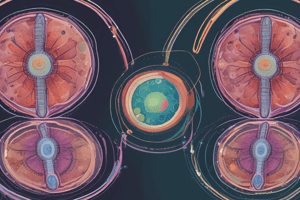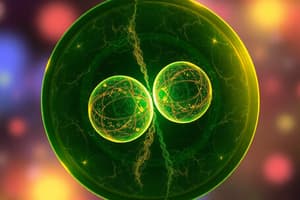Podcast
Questions and Answers
During which stage of mitosis do chromosomes line up in the center of the cell?
During which stage of mitosis do chromosomes line up in the center of the cell?
- Prophase
- Telophase
- Anaphase
- Metaphase (correct)
What happens during Anaphase in mitosis?
What happens during Anaphase in mitosis?
- Chromosomes elongate
- Nuclear membranes break down
- Chromosomes are pulled to opposite ends of the cell (correct)
- Two new cells are formed
Which stage marks the beginning of the cell division process?
Which stage marks the beginning of the cell division process?
- Metaphase
- Cytokinesis
- Prophase
- Telophase (correct)
What is the end result of mitosis in terms of chromosome number?
What is the end result of mitosis in terms of chromosome number?
Why is mitosis important for organisms?
Why is mitosis important for organisms?
What is the primary outcome of mitosis?
What is the primary outcome of mitosis?
During which stage of mitosis does the nuclear membrane begin to break down?
During which stage of mitosis does the nuclear membrane begin to break down?
How many diploid cells are produced after mitosis?
How many diploid cells are produced after mitosis?
What occurs at the beginning of prophase in mitosis?
What occurs at the beginning of prophase in mitosis?
What distinguishes the products of mitosis compared to meiosis?
What distinguishes the products of mitosis compared to meiosis?
What is the primary function of meiosis?
What is the primary function of meiosis?
What is the chromosome number of daughter cells after meiosis in a diploid cell?
What is the chromosome number of daughter cells after meiosis in a diploid cell?
In which phase of meiosis does nuclear division occur?
In which phase of meiosis does nuclear division occur?
How many daughter cells are produced at the end of meiosis?
How many daughter cells are produced at the end of meiosis?
What distinguishes the daughter cells produced by meiosis from those produced by mitosis?
What distinguishes the daughter cells produced by meiosis from those produced by mitosis?
What characterizes benign tumors?
What characterizes benign tumors?
What is the term for the movement of malignant cells to other parts of the body?
What is the term for the movement of malignant cells to other parts of the body?
Which of the following is NOT a common carcinogen?
Which of the following is NOT a common carcinogen?
Which treatment is commonly used for cancer?
Which treatment is commonly used for cancer?
What is generally true about malignant tumors?
What is generally true about malignant tumors?
What is an example of muscular tissue found in animals?
What is an example of muscular tissue found in animals?
Which of the following is NOT a major type of plant tissue?
Which of the following is NOT a major type of plant tissue?
What process involves the growth of cells in a medium outside of the organism?
What process involves the growth of cells in a medium outside of the organism?
Which tissue type provides structural support in plants?
Which tissue type provides structural support in plants?
Which of the following represents a type of connective tissue in animals?
Which of the following represents a type of connective tissue in animals?
Which type of cell contains two sets of chromosomes?
Which type of cell contains two sets of chromosomes?
What is the diploid number of chromosomes in humans?
What is the diploid number of chromosomes in humans?
During which phase of the cell cycle does the cell not divide?
During which phase of the cell cycle does the cell not divide?
In which phase of interphase do chromosomes become very elongated?
In which phase of interphase do chromosomes become very elongated?
Which of the following represents a haploid cell in humans?
Which of the following represents a haploid cell in humans?
What is one of the primary benefits of micropropagation?
What is one of the primary benefits of micropropagation?
What are chromosomes made up of?
What are chromosomes made up of?
Which of the following accurately describes cell continuity?
Which of the following accurately describes cell continuity?
What is the use of the product codeine?
What is the use of the product codeine?
What is a gene responsible for?
What is a gene responsible for?
What defines osmosis in biological systems?
What defines osmosis in biological systems?
Which of the following accurately describes diffusion?
Which of the following accurately describes diffusion?
What characterizes a semi-permeable membrane?
What characterizes a semi-permeable membrane?
In which direction do water molecules move during osmosis?
In which direction do water molecules move during osmosis?
Which process is described as passive and does not require energy?
Which process is described as passive and does not require energy?
What happens to an animal cell placed in a more concentrated solution?
What happens to an animal cell placed in a more concentrated solution?
If an animal cell is placed in a less concentrated solution, what is the likely outcome?
If an animal cell is placed in a less concentrated solution, what is the likely outcome?
What occurs when an animal cell is in a solution of equal concentration?
What occurs when an animal cell is in a solution of equal concentration?
What physical change occurs to a plant cell in a more concentrated solution?
What physical change occurs to a plant cell in a more concentrated solution?
What is the result of water movement in a plant cell when exposed to a concentrated solution?
What is the result of water movement in a plant cell when exposed to a concentrated solution?
Which of the following correctly describes fats?
Which of the following correctly describes fats?
What is the primary function of triglycerides?
What is the primary function of triglycerides?
What characteristic distinguishes phospholipids from triglycerides?
What characteristic distinguishes phospholipids from triglycerides?
Which part of a phospholipid is hydrophilic?
Which part of a phospholipid is hydrophilic?
Which statement about oils is true?
Which statement about oils is true?
Flashcards
Micropropagation
Micropropagation
Growing many plants from small pieces, like cells.
Cell Continuity
Cell Continuity
Cells dividing and living on.
Chromosome
Chromosome
DNA thread in cells; visible during cell division.
Gene
Gene
Signup and view all the flashcards
Codeine use
Codeine use
Signup and view all the flashcards
Haploid cell (n)
Haploid cell (n)
Signup and view all the flashcards
Diploid cell (2n)
Diploid cell (2n)
Signup and view all the flashcards
Cell Cycle
Cell Cycle
Signup and view all the flashcards
Interphase
Interphase
Signup and view all the flashcards
Chromosomes in Interphase
Chromosomes in Interphase
Signup and view all the flashcards
Mitosis definition
Mitosis definition
Signup and view all the flashcards
Mitosis outcome
Mitosis outcome
Signup and view all the flashcards
Prophase – Chromosomes
Prophase – Chromosomes
Signup and view all the flashcards
Prophase – Fibers
Prophase – Fibers
Signup and view all the flashcards
Prophase – Nucleus
Prophase – Nucleus
Signup and view all the flashcards
What happens in Metaphase?
What happens in Metaphase?
Signup and view all the flashcards
What happens in Anaphase?
What happens in Anaphase?
Signup and view all the flashcards
What happens in Telophase?
What happens in Telophase?
Signup and view all the flashcards
Cytokinesis
Cytokinesis
Signup and view all the flashcards
Mitosis
Mitosis
Signup and view all the flashcards
Tissue types in animals
Tissue types in animals
Signup and view all the flashcards
Tissue types in plants
Tissue types in plants
Signup and view all the flashcards
Tissue Culture
Tissue Culture
Signup and view all the flashcards
In vitro growth
In vitro growth
Signup and view all the flashcards
Bioreactors
Bioreactors
Signup and view all the flashcards
Cancer
Cancer
Signup and view all the flashcards
Benign Tumor
Benign Tumor
Signup and view all the flashcards
Malignant Tumor
Malignant Tumor
Signup and view all the flashcards
Metastasis
Metastasis
Signup and view all the flashcards
Carcinogen
Carcinogen
Signup and view all the flashcards
Haploid cell
Haploid cell
Signup and view all the flashcards
Functions of Meiosis
Functions of Meiosis
Signup and view all the flashcards
Prophase I (Meiosis)
Prophase I (Meiosis)
Signup and view all the flashcards
How does cancer relate to mitosis?
How does cancer relate to mitosis?
Signup and view all the flashcards
What are lipids?
What are lipids?
Signup and view all the flashcards
Triglycerides: Function
Triglycerides: Function
Signup and view all the flashcards
Phospholipids: Location
Phospholipids: Location
Signup and view all the flashcards
Phospholipid Structure
Phospholipid Structure
Signup and view all the flashcards
Phospholipid Bilayer
Phospholipid Bilayer
Signup and view all the flashcards
Diffusion
Diffusion
Signup and view all the flashcards
Semi-permeable membrane
Semi-permeable membrane
Signup and view all the flashcards
High water concentration
High water concentration
Signup and view all the flashcards
Low water concentration
Low water concentration
Signup and view all the flashcards
Animal cell in concentrated solution
Animal cell in concentrated solution
Signup and view all the flashcards
Animal cell in less concentrated solution
Animal cell in less concentrated solution
Signup and view all the flashcards
Plant cell in concentrated solution
Plant cell in concentrated solution
Signup and view all the flashcards
Plasmolysis
Plasmolysis
Signup and view all the flashcards
Osmosis in plant cells
Osmosis in plant cells
Signup and view all the flashcards



